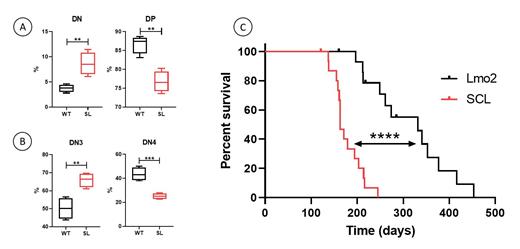Abstract
Background: T-lineage acute lymphoblastic leukemia (T-ALL) is an aggressive hematologic malignancy that accounts for 10%-15% of pediatric and 25% of adult ALL cases. Although the prognosis of T-ALL has been improving over time, the outcome of T- ALL patients with primary resistant or relapsed leukemia remains poor. Thus, further advances in the treatment of T-ALL require the identification of new targets for the development of highly specific molecularly targeted drugs. SRY-related HMG-box 11 (SOX11) is a member of the SOXC family, which also includes SOX4 and SOX12. SOX11 is single-exon gene that encodes a transcription factor, but its molecular properties and functions remain incompletely understood. Expression of SOX11 is strongly associated with neurogenic activity, and it is confined to the central nervous system. Aberrant SOX11 upregulation has been observed in several cancer types, such as medulloblastoma, glioma, and B- and T-cell lymphomas. Under physiological conditions, SOX11 is absent in the T-cell lineage. However, SOX11 expression is consistently found in a subset of TAL/LMO T-ALL cases characterized by an abundancy of PTEN mutations and an underrepresentation of NOTCH mutations. Since the expression of SOX11 is restricted to a malignant context, we postulate that SOX11 might act as an oncogene in T-ALL.
Aims: We want to assess SOX11's potential to promote a (pre)leukemic state, and to identify the role of SOX11 during oncogenic transformation in vivo.
Methods: We generated a R26-SOX11 knock-in mouse model that allows conditional SOX11 expression in thymocytes, by using Lck-Cre (SL). Using this model, we analyzed the (immuno)phenotype and transcriptome of T-cell populations in 8- to 12-weeks old mice. In the future, we will also perform a syngeneic transplantation of SL thymocytes into sublethally irradiated mice to assess their colonizing potential. Additionally, we have set up an aging cohort of SL mice to investigate whether expression of SOX11 suffices to induce malignant transformation. Since the expression of SOX11 is associated with the TAL/LMO subgroup, we also crossed SL mice with a well-established murine T-ALL model, CD2-Lmo2, to give rise to mice that express both transgenes in their thymocytes (SCL). An aging cohort of this T-ALL model was followed, and we generated a survival curve and collected biological samples. These tumor samples are being analyzed, and their transcriptomic profile will be compared with that of mice overexpressing Lmo2 only. Lastly, we will lentivirally transduce human T-ALL cell lines from the TAL/LMO subgroup using a vector for SOX11 expression. These cell-lines will be used to study the consequences of expressing this transcription factor in a pre-established malignant setting.
Results: In order to determine the effects of SOX11 expression in T-cells, we collected and analyzed blood, spleen, and thymus of 12-weeks old SL mice and their Cre-negative littermates (WT). To validate this model, we performed real-time PCR and immunoblotting to confirm the overexpression of SOX11 in T-cells. Interestingly, we observed a significant reduction in the number of lymphocytes in the peripheral blood and in the spleen of SL mice. Furthermore, significant changes were found in the proportions of all thymic populations, featuring an increase in double negative (DN) T-cells (Fig. 1A), particularly the DN3 subpopulation (Fig. 1B), and a decreased double positive CD4/CD8 fraction (DP). Based on that finding, we decided to sort out DN3 and DP cells from WT and SL thymi, and performed RNA-sequencing to further characterize the effect of SOX11 in these cells. In addition, we are following a cohort of SL mice, but so far no tumor formation was observed (average age of the cohort=300-days old). On the other hand, simultaneous overexpression of SOX11 and Lmo2 greatly accelerated the development of T-cell malignancies in SCL mice when compared with CD2-Lmo2 mice (Fig. 1C; median survival of 177 days versus 307; p<0.0001), revealing a synergistic effect upon combination of both genetic events. Not surprisingly, most tumors were composed of immature T-cells, mainly DN cells, and no noteworthy differences were found between the composition and location of SCL and CD2-Lmo2 tumors.
Conclusion: We showed that SOX11 skews the normal development of thymocytes in vivo. Additionally, we developed a murine SOX11 T-ALL model, thus confirming an oncogenic role for SOX11.
No relevant conflicts of interest to declare.


